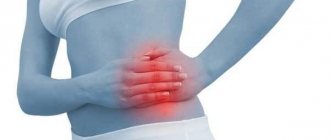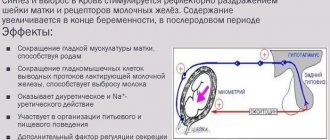Most often, if a child is sick and has a stomach ache, young mothers suspect food poisoning. Most likely, this is the problem.
But we should not forget that such symptoms may also indicate other pathological processes occurring in the baby’s body.
For example, gastroenteritis is a disease of the gastrointestinal tract, which is manifested by the following symptoms: abdominal pain, nausea, vomiting or diarrhea.
It is necessary to consider in more detail the factors that provoke the symptoms in question.
Causes of abdominal pain and nausea in children
These symptoms can be safely called a consequence of intoxication of the body. A child has a stomach ache and feels nauseous when there is any toxin or harmful pathogen in his body.
What exactly caused the nausea and pain can only be determined by a doctor. Therefore, it is not recommended to do anything at home.
The most common factors that provoke the symptoms in question include the following:
- A manifestation of acute intestinal infection is food poisoning. This phenomenon occurs as a result of penetration of a contaminated product into the body. The disease begins very acutely, so the child has a stomach ache and feels sick.
- ARVI is a viral infection that has an acute onset and is accompanied by abdominal pain, cough, runny nose, nausea and fever.
- Intestinal obstruction, which can be congenital or acquired. The congenital form is considered a developmental defect, and the acquired form is considered the result of intussusception. With the development of such a pathology, the child experiences a lack of bowel movements, bloating, pain, vomiting, and nausea. If there is feces, then there are blood impurities in it.
- The onset of appendicitis. The phenomenon under consideration is a pathology of a surgical nature, which is formed due to the inflammatory process in the appendix. When appendicitis develops, the child experiences severe abdominal pain when walking. The pain manifests itself especially sharply on the right side. In addition, the temperature rises, the lower back hurts and there is a violation of bowel movements. The child is feeling sick.
- Cholecystitis is an inflammation of the gastric bladder resulting from the penetration of staphylococcus into the body. Most often, the disease manifests itself at night and makes itself felt by abdominal pain and vomiting.
- Gastritis is an inflammatory process on the mucous membranes of the stomach, which occurs when the body’s immune defense is weakened. The problem may occur in a child who regularly experiences stress. The very first symptom is that the baby has a stomach ache and feels very nauseous.
- Stomach or duodenal ulcer. All parents should be aware that peptic ulcer disease often occurs in a chronic form. It can develop quickly and negatively affect the functioning of internal organs. The main reason for this condition is Helicobacter bacteria, which affects the mucous membrane and makes the stomach too sensitive.
- Allergy. This disease is not always easy to diagnose. But if the stomach hurts immediately after eating and this pain is not caused by overeating, then this indicates that the child’s body does not accept the food.
What to do in such situations? It is recommended not to self-medicate, but to immediately seek help from qualified specialists.
It is worth remembering that the symptoms in question may indicate dangerous pathologies that require urgent surgical intervention and can significantly damage the child’s health.
Symptoms of diseases
In order to understand what is causing the discomfort, it is necessary to localize the pain. Each disease is characterized by pain in a certain place:
- If the baby has a dull pain on the right side in the upper abdomen, which may also be accompanied by nausea, a rise in temperature to 39-40°C, as well as diarrhea with mucous discharge, painful urination, then in this case we may be talking about appendicitis.
- Painful sensations on the left under the ribs. This may indicate a pancreatic disease. If after the activity of the baby, as well as during intense physical activity, pain occurs, then we are talking about improper functioning of the diaphragm, which can be caused by a severe bruise.
- Pain in the stomach extends to the navel area. This may indicate problems with the gastrointestinal tract. This may be a consequence of improper and irregular nutrition. If painful sensations are also accompanied by elevated temperature, then we are most likely talking about poisoning through heavy metals.
- Acute pain in the abdomen. With these painful sensations, the child has difficulty moving, severe tension in the abdominal wall appears, and all this is accompanied by a high temperature. Here we can talk about chronic pathologies of the gastrointestinal tract or the appearance of an intestinal infection.
- Pain occurs on the side. This may indicate inflammatory processes in the kidneys (nephritis). Sharp pain combined with elevated temperature is a reason to urgently call a doctor.
- If there is severe pain in the abdomen, and at the same time the child has an elevated temperature, then it is quite possible that we are talking about peritonitis. Difficulties arise when the child moves. This condition may be caused by complications of gastritis, intestinal obstruction, or exacerbation of appendicitis.
How to provide first aid to a baby
If a child often has stomach pain and vomits, then the child should be shown to specialists. But this is not always possible, so parents should know how to properly alleviate the baby’s condition before the doctor arrives.
There are several recommendations that should be followed when dealing with pain and nausea in a young child. They are:
- The baby needs to be placed on the bed and his upper body raised. The head should be turned to the side to avoid swallowing vomit.
- In cases where the stomach is very painful, the child can be given a tablet of No-shpa, Paracetamol or Ibuprofen. In order to restore the water-salt balance, the child should be given Regidron to drink.
- If abdominal pain and vomiting without fever develop, the child should be raised upright and his head should be held with his hands.
Infants should regularly clean their nose, which can become clogged with stomach contents. To free up the passages, it is recommended to use pears or special drops for the child.
But there are also several actions that are strictly prohibited. This includes washing the stomach at home, applying warm or cold heating pads to the painful area, and feeding the child for the next 6 hours.
Signs of gas and vomiting
Gas is produced when your child swallows ductwork, chews gum, and drinks too quickly. It is also formed when bacteria in the body break down certain foods for digestion. Most of the air in the stomach escapes, but the rest passes through the digestive system to be released as gas, the Centra Care Health Library website notes. However, symptoms of excess gas, bloating, and vomiting may indicate side effects from medications or a gastrointestinal disorder. Additionally, children who experience gas and vomiting after eating may be lactose intolerant. If your child's vomit is green or contains blood, call your doctor immediately.
Traditional recipes for treating abdominal pain and nausea
Everyone knows that almost all medications only temporarily relieve pain, and antibiotics have a negative effect on the stomach and weaken the immune system.
In order to save the baby from suffering, many experts recommend combining traditional treatment with the use of traditional medicine, which will help cleanse the body and not cause harm to it.
There are several proven treatments for abdominal pain and nausea. They are:
- Using potato juice with honey. With the help of such a drink, parents will help their baby to endure an exacerbation of gastritis or stomach ulcer less painfully. To prepare the drink, pour water into a bowl, grate fresh potatoes into it and strain. Add a few tablespoons of honey to the resulting mass. The drink should be put in a cool place for a couple of hours and allowed to brew. It is better to take the product in the evenings, when the last meal has already been taken.
- The use of plantain and chamomile. To get rid of severe pain in the child’s stomach, the mother should prepare the following tincture: take dry chamomile and plantain, mix everything well, add a small amount of water and place on low heat. Bring the mixture to a boil, turn the heat even lower and let it simmer for about half an hour. When the tincture is completely boiled, you should add some blueberries to it and leave it alone for 5 hours. After this, the broth is filtered and given to the child 7 times a day in small doses.
- A combination of gooseberries, honey and dandelion. You need to prepare fresh dandelions, grind them in a meat grinder, add honey to the mixture and mix thoroughly.
Pour boiling water over the resulting mixture and add gooseberries. Then the container is placed on the fire, boiled and boiled for about 15 minutes. When the product has cooled, it can be given to a baby who has abdominal pain and vomiting.
All parents are ready to take upon themselves the torment of their little child. But, alas, this cannot be done, so you need to try to alleviate his suffering by surrounding him with care and love.
To ensure that all the symptoms under consideration, indicating dangerous pathological conditions, do not provoke serious complications, the baby should be shown in a timely manner to qualified specialists who will conduct the necessary examination, establish an accurate diagnosis and prescribe adequate treatment, if necessary.
It is very important to monitor what your baby eats and drinks, take him for walks in the fresh air more often, strengthen his body and strengthen his immune system.
If you follow these recommendations, the disease will progress quickly and without various life-threatening complications.
Prevention
There are no specifically designed preventive measures against vomiting. However, parents should:
- provide balanced nutrition that is appropriate for the child’s age;
- limit your baby from stress;
- ensure that children do not have easy access to medications;
- exclude contact with allergens;
- Regularly undergo a complete medical examination with your child.
Often the outcome of vomiting in children is favorable, and complications are quite rare.
Possible reasons
Most often, when young parents experience nausea and abdominal pain in their child, they suspect overeating or food poisoning. But we must not forget that these symptoms are also characteristic of other pathological conditions.
For example, nausea and pain in the epigastric region immediately or some time after eating may indicate the presence of gastritis or a stomach ulcer. These conditions are quite common, especially among adolescents due to irregular and low-quality nutrition.
Also, unpleasant symptoms are characteristic of the following diseases:
- gastroenteritis. This gastrointestinal pathology is manifested by nausea, diarrhea, vomiting, and increased body temperature. It has infectious (viruses, bacteria, protists) and non-infectious genesis (individual intolerance). Gastroenteritis usually begins acutely;
- ARVI. The condition is characterized by body aches, fever, nausea, cough and runny nose. Sometimes there may also be abdominal pain;
- appendicitis. Pathology occurs due to inflammation in the appendage of the cecum. In this condition, the child experiences severe pain in the abdomen and lower back when moving, hyperthermia, nausea, and impaired bowel movements;
- intestinal obstruction. It can be acquired as a result of intussusception or congenital if caused by a developmental defect. This disease is characterized by the absence of bowel movements, severe bloating, nausea, pain, and vomiting. If feces come out in small quantities, then blood inclusions are observed in them;
- cholecystitis. It is an inflammation of the gallbladder. Manifested by abdominal pain and nausea. In acute cases, vomiting, hyperthermia, and weakness are possible. Symptoms intensify after the child eats fatty foods, overeats, or goes hungry;
- duodenal ulcer. The disease is chronic. It develops quite quickly. May adversely affect the functioning of internal organs;
- constipation. Accompanied by mild abdominal pain, nausea, and lack of appetite. Constipation often occurs due to insufficient fluid intake, against the background of cholecystitis, addiction to sweets and flour products;
- acetonemic syndrome. It occurs occasionally, accompanied by vomiting and abdominal pain. Caused mainly by dietary errors, which leads to an increase in the plasma concentration of ketone bodies. In most cases, it goes away on its own after 5 years;
- hepatitis, liver cirrhosis. In addition to abdominal pain and nausea in the child, parents will notice yellowing of the skin, hyperthermia, and weakness;
- helminthic infestation. Accompanied by signs of intoxication. The baby may experience sudden weight loss, changes in taste preferences, and itching in the anus.
Nausea and abdominal pain often occur in children who do not eat enough
Also, abdominal pain and nausea appear during hunger. In this case, they disappear after eating. Determining the exact cause of the pathological condition can be difficult. To understand why a child feels unwell, you need to analyze his lifestyle, nutrition, and undergo a series of diagnostic procedures.
Video on the topic
What to do if your child has diarrhea or vomiting and a stomach ache:
Thus, abdominal pain and nausea can be signs of different diseases. You can suspect the cause of a child’s poor health by the location and nature of the pain. If unpleasant symptoms are observed frequently and severely, then you need to consult a doctor.
A healthy child is usually active and mobile. The baby's passivity, his whims and crying, poor sleep and lack of appetite are a reason for parents to pay closer attention to the state of his health, because young children often cannot complain about feeling unwell. When a child has a stomach ache and vomiting with fever, these are alarming symptoms that parents should not ignore.
The content of the article:
After all, we are talking not just about banal food poisoning, but a serious illness when the baby needs professional medical help. Sudden abdominal pain in a child may appear due to a change in diet with a new type of complementary food or due to excessive consumption of sweets and soda. But frequent attacks of vomiting and abdominal pain in a baby are a reason to show him to the pediatrician.
Vomiting after antibiotics
Antibiotics are a very serious thing, which is sometimes simply impossible to do without. Many diseases cannot be treated without serious antibiotic therapy. You should not prescribe antibiotics yourself, because they can have many side effects. Only a doctor should prescribe antibiotics. Otherwise, nausea, vomiting and indigestion may occur.
Nausea occurs with severe endocrine diseases such as adrenal insufficiency, diabetic acidosis, and so on. In early pregnancy, nausea occurs due to hormonal changes.
Chemotherapy drugs and drugs have many side effects, including headaches, nausea and vomiting. The medicine irritates the gastric mucosa and the medulla oblongata receives a signal that it is time to cleanse it.
What should parents do?
Many parents do not know what to do if their child feels sick and has a stomach ache.
It all depends on the severity and duration of symptoms, the presence of concomitant manifestations. If pain and nausea do not go away and become more intense and regular, then you need to consult a pediatrician, do an ultrasound of the abdominal cavity, and consult a gastroenterologist.
If the unpleasant sensations are caused by overeating or starvation, then it is necessary to review and make adjustments to the child’s diet and diet. If the baby has repeated vomiting and fever, then you need to urgently call a medical team.
Before the doctors arrive, you should provide first aid to the baby:
- put the child in bed, raising the upper body slightly and turning the head to the side. This will prevent ingestion of vomit;
- to restore the water-salt balance, you should use Regidron;
- In case of severe spastic pain, it is forbidden to give any painkillers before examination by doctors. This distorts the clinical picture of the disease and a life-threatening disease may not be diagnosed in time.
Conditions
Bloating and vomiting are some symptoms of gastroparesis, a paralysis of the abdominal muscles that prevent or delay the stomach from emptying its contents into the small intestine. Causes of this condition include diabetes and hypothyroidism. The Mayo Clinic notes that intestinal obstruction also causes abdominal pain and bloating, nausea, and vomiting. Additionally, irritable bowel syndrome or IBS is a common condition that causes cramping, abdominal pain, bloating, gas, diarrhea and sometimes constipation. According to the Mayo Clinic, certain foods, such as chocolate and some fruits and vegetables, stress and hormones can trigger these symptoms. Finally, appendicitis affects children ages 10 and older. Symptoms include pain that starts around the navel and moves to the lower right abdomen, nausea, vomiting and abdominal swelling. This way, your baby won't be able to pass gas, notes the Mayo Clinic. If you feel that your child is suffering from any of these conditions, consult a doctor immediately.











